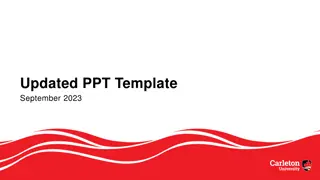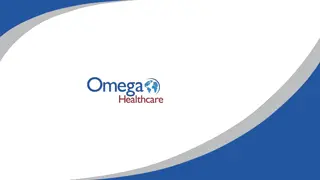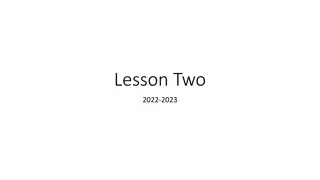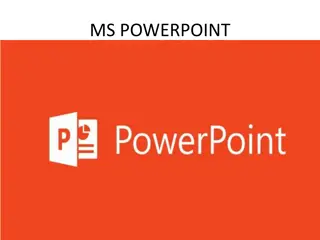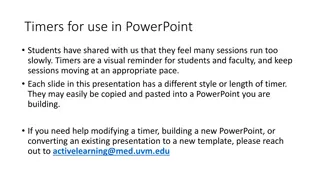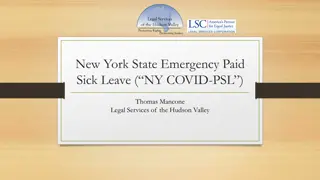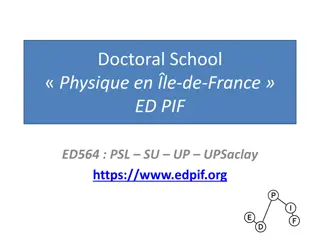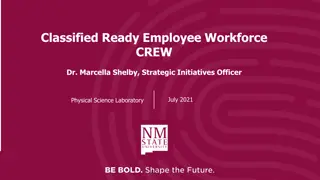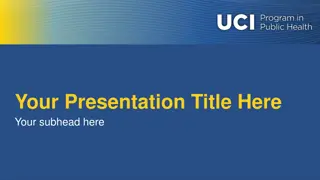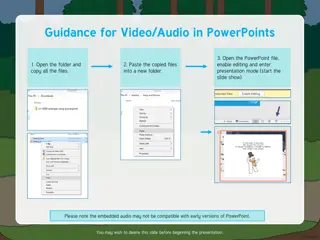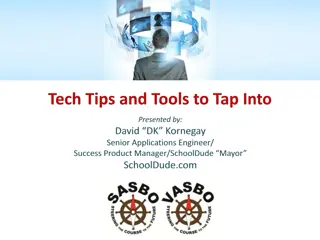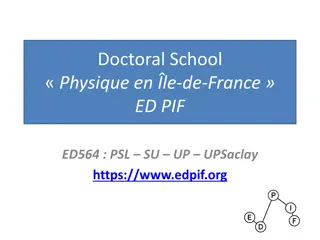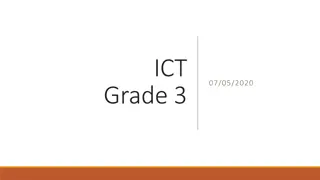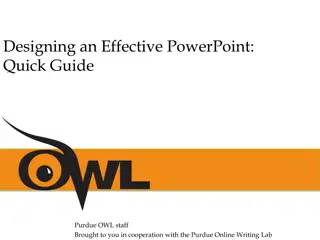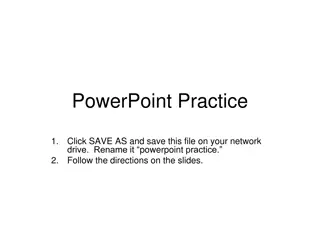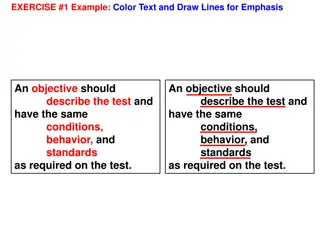
Understanding Connecticut's New Paid Sick Leave Law
Learn everything Connecticut businesses need to know about the state's new paid sick leave law, including covered employers, exempt employers, covered employees, reasons for taking sick leave, accrual process, notice requirements, and more. Stay informed to ensure compliance with the law and support your employees' well-being.
Download Presentation

Please find below an Image/Link to download the presentation.
The content on the website is provided AS IS for your information and personal use only. It may not be sold, licensed, or shared on other websites without obtaining consent from the author. If you encounter any issues during the download, it is possible that the publisher has removed the file from their server.
You are allowed to download the files provided on this website for personal or commercial use, subject to the condition that they are used lawfully. All files are the property of their respective owners.
The content on the website is provided AS IS for your information and personal use only. It may not be sold, licensed, or shared on other websites without obtaining consent from the author.
E N D
Presentation Transcript
1 Connecticut's New Paid Sick Leave Law: Everything CT Businesses Need to Know Department of Labor Legal Division Attorney Heidi Lane September 12, 2024 Hosted by CTDOL s Business Engagement Unit
Who is a covered employer on Jan 1st, 2025, and who will be a covered employer in the coming years? Are any employers exempt? What employees are covered and are there any exempt employees? Which employees are considered seasonal ? What are the reasons for which paid sick leave may be taken? Who is a family member? How is sick leave accrued? How much paid sick leave may be accrued in a year? What are the notice requirements for both the employer and the employee? What documentation may the employer require? AGENDA 2
"Employer" - means any person, firm, business, educational institution, nonprofit agency, corporation, limited liability company or other entity, including municipalities and the state COVERED EMPLOYERS January 1, 2025 employers with 25 or more full-time and part-time employees in CT 3
January 1, 2026 employers with 11 or more full-time and part-time employees in CT COVERED EMPLOYERS January 1, 2027 employers with 1 or more full-time and part-time employees in CT Number of employees is based on employer s payroll for the week containing January 1st, annually 4
EXEMPT EMPLOYERS Employers participating in multiemployer health plans, maintained pursuant to one or more collective bargaining agreements between a construction-related tradesperson employee organization(s) and employers. Employers with fewer than the number of employees listed on the previous 2 slides. Self-employed individuals. 5
Only the following employees are excluded: EMPLOYEES EXCLUDED FROM THE Seasonal employees, and Individuals who are members of construction-related tradesperson employee organizations that are part of a multiemployer health plan maintained pursuant to one or more collective bargaining agreements between a construction-related tradesperson employee organization(s) and employer. LAW 6
CONSTRUCTION-RELATED TRADESPERSON EMPLOYEE ORGANIZATION This refers to certain construction worker unions and their employers. If you are a construction worker in a union, or an employer of construction workers in one or more unions, consult your collective bargaining agreements. If the contract contains an obligation that a multiemployer health plan be maintained, then the employer and employee covered by that agreement are exempt. 7
SEASONAL EMPLOYEE An employee who works 120 days or less in any year Work-days and not calendar days 8
Employers need to be mindful of the employee who is hired to work less than 120 days in a year and ends up working more than 120 days On day 121, that employee would be entitled to what they should have accrued during the previous 120 days and be able to begin using paid sick leave. ISSUE WITH SEASONAL EMPLOYEE Best Practice? 9
The employee or their family member is ill, injured or suffering from a health condition. The employee or their family member is obtaining a medical diagnosis or treatment of a mental or physical illness or injury. The employee or their family member is seeking preventative medical care for either mental or physical health. A mental health wellness day. Either the employer s place of business or a family member s school or place of care closes by order of a public official due to a public health emergency. A health authority, the employer of the employee or the employee s family member, or a health care provider determines that the employee or employee s family member poses a risk to the health of others because of exposure to a communicable disease. REASONS FOR LEAVE 10
If the employee or their family member is a victim of family violence or sexual assault and time off is needed for the following: Medical care; Counseling (psychological or other); Obtaining services from a victim services organization; Relocating; or Participating in civil or criminal proceedings. REASONS FOR LEAVE Note: the need for leave due to family violence is similar to the leave provided in Connecticut General Statutes 31-51ss, which provides 12 days of unpaid leave for victims of family violence. However, the 12 unpaid days are in addition to any other leave under 31-51ss, so employers are prohibited from requiring the employee to use those days concurrently with the paid sick leave. 11
Can an employer take disciplinary action against an employee who utilizes paid sick leave for a purpose other than those permitted under the law? Yes 12
Mental health wellness day: a day during which an employee attends to their emotional and psychological well-being in lieu of attending a regularly scheduled shift DEFINITIONS 13
Family member: a spouse, sibling, child, grandparent, grandchild, or parent of an employee, or an individual who is related to the employee by blood or by an affinity whose close association the employee can show to be equivalent to those family relationships. Child: a biological, adopted, or foster child, stepchild, or legal ward of an employee who is standing in loco parentis, or an individual to whom the employee stood in loco parentis when that individual was a child. The child can be of any age. Grandchild: related to a person by blood, marriage, adoption, or foster care, by a child of the grandparent. DEFINITIONS 14
Parent: a biological, foster, or adoptive parent, stepparent, parent-in-law, or legal guardian of an employee or the employee s spouse. A parent can also be an individual who is now standing (or has previously stood) in loco parentis to an employee. In loco parentis: standing in the place of the parent. Sibling: a brother or sister related to the employee by blood, marriage, adoption, or foster care placement. Spouse: a person who is legally married to an employee under the laws of any state, or a domestic partner of an employee registered under the laws of any state or political subdivision. DEFINITIONS 15
ACCRUAL Accrual begins on January 1, 2025, unless the employee was hired after that date. If hired after January 1, 2025, the employee s paid sick time begins to accrue on the employee s first date of employment. This is the same timeline (January 1) for the employers who are phased in on January 1, 2026, and January 1, 2027. 16
ACCRUAL Each employer shall provide paid sick leave annually, which accrues: at a rate of 1 hour of paid sick leave for every 30 hours worked by the employee, and must be hours actually worked and does not include any paid or unpaid time off Year means any 365-day period used by the employer to calculate employee benefits 17
ACCRUAL Employees who are exempt from overtime are presumed to work 40 hours per week but will not accrue paid sick leave for any hours worked over 40 hours per week. Employees who are exempt from overtime and whose normal work week is less than 40 hours will accrue paid sick leave for the number of hours normally worked. 18
USAGE An employee may begin to use accrued hours 120 calendar days after their date of hire. This is a one-time requirement. Once met, it never needs to be met again for the same employer or an employer that is a successor in interest. 19
Employers are required to allow employees to use accrued paid sick leave in 1 hour increments regardless of the employer s time- keeping system. Employees are not entitled to use the paid sick leave in lesser increments, unless allowed by the employer. USAGE 20
Employees are entitled to accrue and use a maximum of 40 hours of paid sick leave per year and employers are not obligated to provide more. CARRY OVER: What happens if an employee does not use all of their 40 accrued hours in one year? Any hours accrued in the current year that are unused can be carried over into the next year. Employers may also provide options for any accrued hours that the employee does not use during the year to be paid out at the end of the year. In lieu of carry over, employers may front load the amount of paid sick leave that the employee would be entitled to at the beginning of the new year. 21
DOCUMENTATION? Employers are prohibited from requiring employees to provide any documentation showing that their leave is being taken for a permitted purpose under the law. 22
The law does not require the employee to provide their employer advance notice of their need to use paid sick leave. EMPLOYEE NOTICE? 23
Employers must: Display posters in English and Spanish, in conspicuous and accessible areas, and Provide written notice to each employee no later than either January 1, 2025, or the employee s first day of employment, whichever is later. Employers with remote employees must either send the posters via e- mail to each remote employee or publish the posters on a digital platform that is known by and accessible to all employees. Posters and sample notice will be on our website EMPLOYER NOTICE 24
PAY RATE Employer must pay the employee for paid sick leave at a pay rate equal to the greater of either: the normal hourly wage for that employee, or the minimum fair wage rate under CGS 31-58 in effect for the pay period during which the employee used paid sick leave. For any employee whose hourly wage varies depending on the work performed, the "normal hourly wage" is the average hourly wage of the employee in the pay period prior to the one in which the employee used paid sick leave. 25
PAY RATE Employees who earn tip credit because hourly rate is lower than minimum wage, must be paid minimum wage for any paid sick leave hours used. Overtime and commissions not part of normal hourly wage. 26
Any termination of an employees employment, whether voluntary or involuntary, shall be considered a break in service. If worker is subsequently rehired by the employer following a break in service, the employee: loses all paid sick leave accrued prior to the break retains the calendar days worked towards the 120 calendar days requirement, and begins to accrue sick leave upon rehire BREAK IN SERVICE 27
Ive been terminated. Am I entitled to pay out of my accrued sick leave? No unless . 28
Employer is in compliance with the law if the employer offers any other paid leave, or combination of other paid leave, that: may be used for the reasons defined in the law, and is accrued in total at a rate equal to or greater than the rate of 1 hour per every 30 hours worked, for a total of 40 hours per year. Other paid leave" - may include, but not be limited to, paid vacation, personal days or paid time off. COMPLIANCE 29
What if our paid time off plan allows employees to accrue more than 40 hours of paid sick leave per year? Employers who allow for more than 40 hours of paid sick leave may limit the use of the additional hours over 40. Employers may apply their normal attendance and time off policy applied to those hours used over 40. Employers may require documentation before permitting the use of any hours over 40. 30
My employer was bought out by a new company and I am remaining employed with the new company. What happens to my accrued sick leave? You retain and may use all paid sick leave that was accrued or received under the previous employer, similar to a successor-in-interest. 31
I was transferred to a new division, entity or job site, but I m still under the same employer. What happens to my accrued sick leave? You retain and may use all paid sick leave that was accrued or received at the previous division, branch, or site in CT. 32
An employer may voluntarily establish a paid sick leave donation policy DONATION An employee donating paid sick leave no longer has that donated paid sick leave available for his or her own use 33
Can an employee choose to work additional hours or shifts during the same or following time period instead of using paid sick leave? Yes, with employer s permission. 34
Can an employer require employees to find a replacement to work their scheduled hours before they can use their accrued paid sick days? No. Employers are prohibited from requiring employees to find replacements before allowing them to use their accrued paid sick leave. 35
EFFECT OF LAW ON COLLECTIVE BARGAINING AGREEMENT The changes cannot override terms of any collective bargaining agreement effective January 1, 2012, or July 1, 2012, pursuant to chapter 319pp. The changes cannot diminish the rights already granted in a bargaining agreement.
RECORDKEEPING Employers must track and keep records of hours worked and paid sick leave accrued and used, for every employee, as part of its normal record-keeping obligations. This can be done electronically but only with each employee s consent. Records must be conveniently, securely, and privately accessible to and printable by the employee. These records must be kept for at least 3 years. Employers must give CTDOL access to those records for monitoring and compliance. Failure to maintain and provide reasonable access to these records is a violation of law and may result in a $100 civil penalty per violation. 37
No employer shall take retaliatory personnel action or discriminate against an employee because the employee: Requests or uses paid sick leave either in accordance with the law or the employer's own paid sick leave policy, or Files a complaint with CTDOL alleging a violation of the law. "Retaliatory personnel action" - means any termination, suspension, constructive discharge, demotion, unfavorable reassignment, refusal to promote, disciplinary action or other adverse employment action taken by an employer against an employee. RETALIATION 38
COMPLAINT PROCESS Any employee may file a "workplace standards complaint with CTDOL s Wage and Workplace Standards Division. The form is on CTDOL s website. The complaint will be investigated by reviewing the complaint, speaking with the Complainant and Employer, and examining employment records. How does an employee file a complaint? What happens during the complaint process? If a hearing is held, CTDOL will hold a formal administrative hearing pursuant to the Uniform Administrative Procedure Act. The parties may either engage a representative or represent themselves at any stage of the complaint process. As part of the complaint process, CTDOL will engage the parties in mediation to try to resolve the complaint. CTDOL has discretion to determine whether the complaint will go to a hearing. 39
COMPLAINT PROCESS After a formal administrative hearing, if the Labor Commissioner finds that the employer, by a preponderance of the evidence, has violated the act, the employer will be liable for civil penalties. Employers found by the Commissioner to be in violation will be liable to CTDOL for a $100 civil penalty per violation. The Commissioner can award the employee payment for used sick leave, reinstatement to the employee s previous position, and payment of back wages. The Commissioner can also reestablish any employee benefits that the employee would have received if a violation had not occurred. The Commissioner s decision can be appealed to Superior Court. There is no private right of action otherwise. 40
CONTACT INFORMATION Wage and Legal Division Workplace Standards Division DOL.legaldivision@ct.gov (860) 263-6755 (860) 263-6791 41

